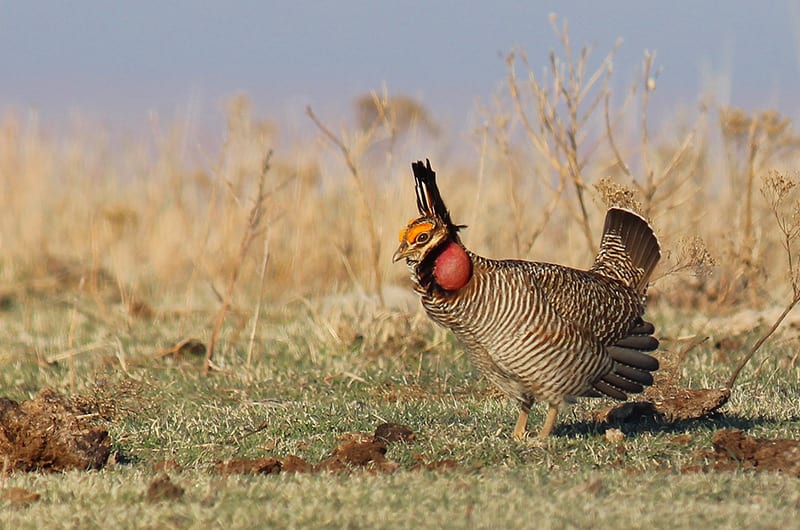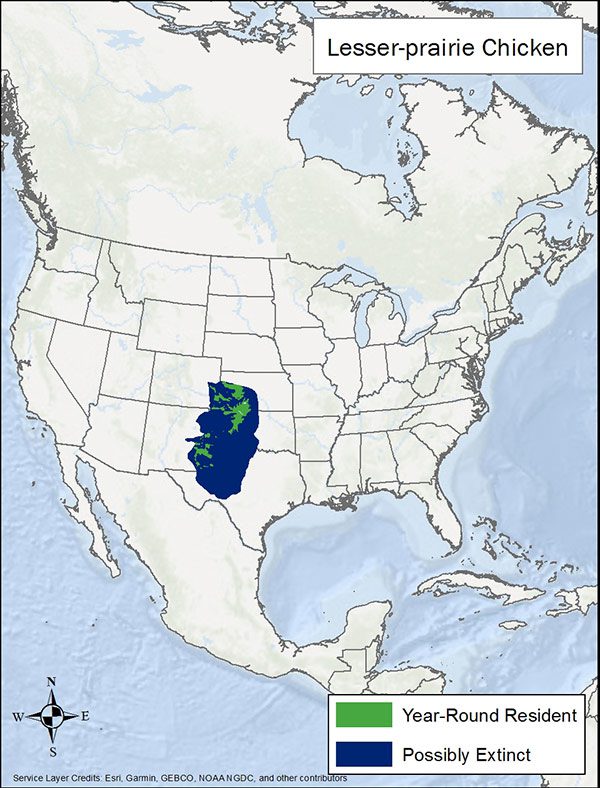LandPKS Learning
Habitat Hub

Lesser Prairie-Chicken
The lesser prairie-chicken has one of the smallest population sizes of grouse species in North America (estimated 28,000 birds) with an estimated decline of 97% from historic numbers. The lesser prairie-chicken is not currently listed for federal protection under the Endangered Species Act.
Tympanuchus pallidicinctus
Identification
Compared to the greater prairie-chicken, lesser prairie-chickens are generally smaller weighing about 1.5 lb/0.7 kg. Both sexes have grayish-brown and white barring and short tails, but males also have yellow-orange eye combs, reddish air sacs they inflate and pop during the breeding display. Lesser prairie-chickens are a resident species in the southern Great Plains. They are non-migratory but will move between seasonal habitats throughout the year.
Observation Tips
Lesser prairie-chickens are most easily observed in the spring when males gather on traditional breeding sites (also known as leks) to display and mate with females. Each male defends a small territory on the lek. They raise their ear pinnae (long neck feathers) and tails, stamp their feet, pop their air sacs, and lower their wings. They also cackle and beat their wings as they leap into the air to fight other males or impress females. Lesser prairie-chickens will also gather in larger flocks in the fall.
Interesting Fact
The lesser prairie-chicken has one of the smallest population sizes of grouse species in North America (estimated 28,000 birds) with an estimated decline of 97% from historic numbers. About 95% of the lesser prairie-chicken range falls on private land, making private landowners a critical part of the management needed for the species. The lesser prairie-chicken is not currently listed for federal protection under the Endangered Species Act.
Ideal Habitat
Ideal habitat consists of open, relatively flat rangeland with a diversity of native, short to mid-height grasses and forbs interspersed with low-growing shrubs, usually sand sagebrush. The southern habitat consists of shinnery oak/bluestem habitat dominated by sand bluestem, little bluestem, Indiangrass, switchgrass, buffalograss, sand dropseed, and sand sagebrush. The northern habitat consists of sand sagebrush communities dominated by sand dropseed, sideoats grama, little and sand bluestem.
Leks may occur in idle agricultural fields, elevated knolls and ridges, or other areas with low-growing vegetation to increase visibility. In general, nesting habitat consists of 65% grass cover, 20-30% shrub cover, and 5-15% forb cover. Brood-rearing habitat typically has less grass with more shrub and forb cover for thermal protection and predator avoidance, some bare ground is also needed for chick mobility. Chicks eat a variety of insects, such as leafhoppers, beetles, and grasshoppers. Adults eat insects, sage and shinnery oak leaves, buds, and acorns, and some crops (corn, sorghum, alfalfa, and wheat).

Range map provided by BirdLife International
Management Activities that Benefit Species – Best Management Practices (BMPs)
In general, promote approximately 1,280 ac/518 ha of nesting and brood-rearing habitat surrounded by 10,000 ac/4,047 ha of mostly intact habitat. If large stock tanks are used for livestock, wildlife escape ladders in the tanks can provide an escape route for birds and other wildlife that become trapped in the water. Mark fences with flagging or similar means to prevent prairie-chicken collisions. Grazing management plans should promote the diversity of habitats and necessary vegetation structure for nesting and brood-rearing periods. Because lesser prairie-chickens avoid habitat with trees, removing eastern red cedars and mesquite with mechanical methods or prescribed fire should increase use. Retiring agricultural fields to the Conservation Reserve Program will benefit lesser prairie-chickens by creating more grassland habitat.
Management Activities to Avoid
Avoid applying herbicides to control weeds and other plants, which can reduce necessary vegetative cover for the lesser prairie-chicken and also reduce insect prey. Installing power lines, towers, buildings, or oil and gas infrastructure should also be avoided near lesser prairie-chicken leks. Avoid additional conversion of native rangeland within two miles of known leks.
Other Species that Benefit from Similar Habitat Management
Lesser prairie-chickens management may benefit Cassin’s sparrows, burrowing owls, scaled quail, pronghorn antelope, ornate box turtles, and Texas horned lizards.
Download
Download the Lesser Prairie-Chicken factsheet
Descarga la ficha de gallo de las praderas chico
Other Resources
BirdLife International and Handbook of the Birds of the World. 2019. Version 2019.1. Lesser prairie-chicken
NatureServe, 2019. NatureServe Explorer: An online encyclopedia of life [web application]. Version 7.1. NatureServe, Arlington, Virginia. Lesser prairie-chicken,
The Cornell Lab of Ornithology, Birds of the World (Lesser prairie-chicken)
The Cornell Lab of Ornithology, All About Birds (Lesser prairie-chicken)
USDA, Natural Resources Conservation Service. 2011. Improving lesser prairie-chicken habitat through revegetation and rangeland management
USDA, Natural Resources Conservation Service. Working Lands for Wildlife, Lesser prairie-chicken Initiative FY16-18 Conservation Strategy.
Photo Credit: Greg Kramos, USFWS / Flickr
Mobile App | Data Portal | Knowledge Hub | Habitat Hub | Learning Collections | Blog | About | Contact | Support



